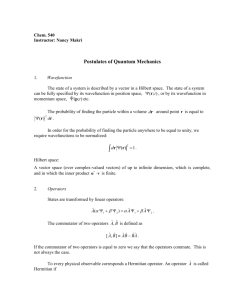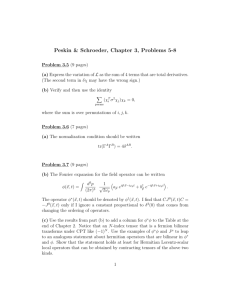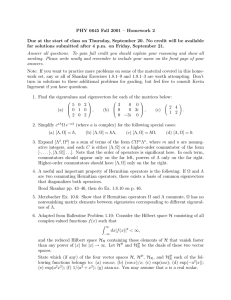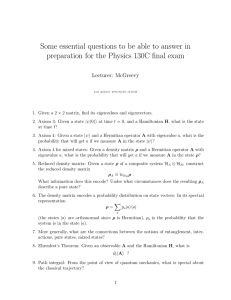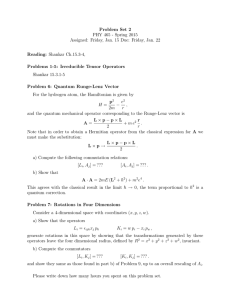Set 6 Problem
advertisement
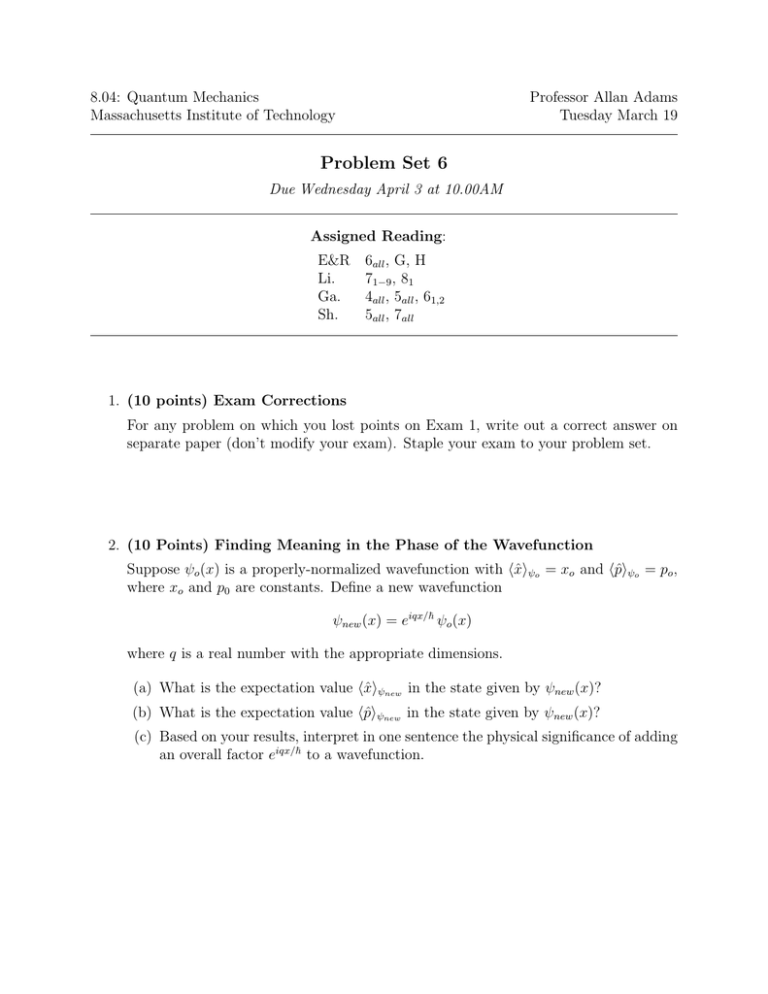
8.04: Quantum Mechanics Massachusetts Institute of Technology Professor Allan Adams Tuesday March 19 Problem Set 6 Due Wednesday April 3 at 10.00AM Assigned Reading: E&R 6all , G, H Li. 71−9 , 81 Ga. 4all , 5all , 61,2 Sh. 5all , 7all 1. (10 points) Exam Corrections For any problem on which you lost points on Exam 1, write out a correct answer on separate paper (don’t modify your exam). Staple your exam to your problem set. 2. (10 Points) Finding Meaning in the Phase of the Wavefunction Suppose ψo (x) is a properly-normalized wavefunction with (x̂)ψo = xo and (p̂)ψo = po , where xo and p0 are constants. Define a new wavefunction ψnew (x) = eiqx/n ψo (x) where q is a real number with the appropriate dimensions. (a) What is the expectation value (x̂)ψnew in the state given by ψnew (x)? (b) What is the expectation value (p̂)ψnew in the state given by ψnew (x)? (c) Based on your results, interpret in one sentence the physical significance of adding an overall factor eiqx/n to a wavefunction. 2 8.04: Problem Set 6 3. (15 points) Relation between Wavefunction Phase and Probability Current Consider a particle with mass m in the state described by the wavefunction ψ(x). We can always express the wavefunction in amplitude-phase form as, ψ(x) = A(x)eiθ(x) , where A(x) and θ(x) are real functions. (a) Show that the probability current is given by J = |A(x)|2 n ∂x θ(x) m i.e. the probability current is proportional to the gradient of the phase. (b) Show that there can be no current in a region where the wavefunction is real. (c) How large is the current for a plane wave of wavevector k? (d) Calculate the current in a region where the wavefunction is given by Beαx +Ce−αx , where α is a real constant and B, C are complex numbers, i.e. B, C are not position-dependent. Is it correct to say that since e±αx are real functions, the current inside the barrier must be zero? Find a condition on B and C such that the current vanishes. This problem will play an important role for us next week! 8.04: Problem Set 6 3 4. (15 points) Odd-parity Energy Eigenstates in the Finite Square Well Consider the finite square well potential of depth Vo and width 2L, −Vo |x| ≤ L V (x) = 0 else where Vo and L are real, positive constants. We examined the even-parity bound state solutions in lecture. In this problem, you are to analyze the odd-parity bound states. (a) The width, L, sets a characteristic length scale for our finite well. Use dimensional analysis to identify a second characteristic length scale, Ro , and a dimensionless measure of the overall size of the well, go . Give a physical interpretation to Ro . (b) Derive a transcendental equation for the allowed energies and solve it graphically. Hint: Work with dimensionless variables and parameters! (c) Examine the two limiting cases of a wide, deep well (go » 1) and a shallow, narrow well (go « 1), and describe character of the solutions in each limit. Is there always at least one odd bound state? If not, what is the condition on go such that an odd bound state exists? What is the corresponding condition on L, holding Ro fixed, or on Ro holding L fixed? (d) Explore the dependence of the energy eigenstates on L and Vo by playing with the “one well” part of the PhET Quantum Bound State applet. Print out a screen that shows two different wells both with precisely four bound states. How do the widths of the evanescent tails vary as the binding energy goes to zero? 4 8.04: Problem Set 6 5. (35 points) Quantum Glue Consider a one-dimensional system described by a particle of mass m in the presence of a pair of delta function wells of strength Wo > 0 located at x = ±L, i.e. V (x) = −Wo δ(x + L) − Wo δ(x − L) . This is a rough but illuminating toy model of an electron in the presence of two positive charges located at x = ±L. (a) Derive a transcendental equation for the allowed eigenenergies of any bound states. o Express your result in terms of the dimensionless quantities go = mLW and n2 n2 κ2 ξ = κL, where E = − 2m is the (negative) energy of the bound state. (b) Solve your transcendental equation(s) graphically / numerically to identify all bound state energy eigenvalues. How many bound states exist? Does the number depend on go ? (c) Plot all bound state energy eigenfunctions for go = 0.1, go = 1 2 and go = 10. (d) How does the energy of the most tightly bound state vary as you vary L? Include a plot (with axes and units labeled) which shows the energy as a function of L. Note: You do not have to do this analytically – this is most easily done numerically using Mathematica. (e) Suppose we place the particle in the lowest energy bound state. Do the two delta functions want to be close together or far apart? Plot the induced force between the delta functions as a function of L. Again, best done numerically. (f) Use the above to suggest a plausible explanation for why H+ 2 is a stable molecule. (g) Use the PhET Quantum Bound State applet to explore the dependence of the energies of the various bound states of a pair of identical wells as a function of the distance between the wells and the shape of the wells themselves. How does the splitting between levels change as you increase the separation between the wells? Why does the 2rd excited state have the same number of nodes inside each well as the 3rd excited state, but not the same number as the 4th? 8.04: Problem Set 6 5 6. (15 points) Further Facts about Hermitian Operators and Commutators Recall that the Hermitian Adjoint of an operator  is defined as the operator † such that, for all functions f (x) and g(x), ˆ |g) . (f |Aˆ† g) = (Af ˆ )∗ . (a) Show that (f |† g) = (g|Af (b) Show that (in)† = −in. (c) Show that (ÂB̂)† = B̂ † † . ˆ Recall that an operator is Hermitian if it is equal to its own Adjoint, † = A. ˆ B]. ˆ Henceforth, let  and B̂ be Hermitian operators, and define Ĉ = [A, (d) Show that Ĉ † = −Ĉ. Such an operator is called anti-Hermitian. ˆ are all real. (e) Show that the eigenvalues of the Hermitian operators Aˆ and B (f) Show that the eigenvalues of the anti-Hermitian operator Ĉ are all imaginary. ˆ J] ˆ = −sJˆ, where s is a real quantity and K ˆ is Hermitian. (g) Suppose [K, i. Is Jˆ Hermitian? ˆ Jˆ† ] = +sJˆ† . ii. Show that [K, ˆ k ) is an eigenfunction of K ˆ k = kϕk . Show that (Jϕ ˆ with eigen­ iii. Suppose Kϕ value (k − s). iv. Show that (Jˆ† ϕk ) is an eigenfunction of K̂ with eigenvalue (k + s). ˆ Jˆ and Jˆ† ? v. In the harmonic oscillator, what operators play the role of K, 6 8.04: Problem Set 6 Aside: Why Hermitian? We’ve taken it as a postulate that observables in Quantum Mechanics are represented by Hermitian operators, with the observable values determined by the spectrum of eigenvalues of the operator. We’ve justified the restriction to Hermitian operators by requiring all observables to be real. However, it is easy to construct matrices which have all real eigenvalues but which are not real - for example, consider the matrix M= −1 i 0 1 M† ≡ MT∗ = , −1 0 −i 1 . M ’s eigenvalues are both real (±1), but M is explicitly not Hermitian (M † = M ). So clearly reality of the eigenvalues is not enough. What gives? In fact, we need to add one more requirement – observable operators must admit a basis of orthonormal eigenvectors in order for the rest of the rules of QM to make sense. ˆ . By construction, both eigenvalues are real To see why, consider again our operator M and non-degenerate. However, the corresponding eigenvectors are not orthogonal: φ−1 = 1 0 , φ+1 = i 2 , (φ−1 |φ+1 ) = i , as you can easily check. Now consider the consequences! If I tell you that a sample system in my lab is observed to have M = +1, you’d say, “cool, by the rules of QM, I deduce that ψ = √15 φ+1 , with the coefficient chosen to normalize the state, (ψ|ψ) = 1.” Fair enough. However, if I then ask you whether a subsequent measurement might give M = −1, you are obliged to reply, “the rules of QM say that the probability of measuring m in the state ψ is Pψ (m) = |(φm |ψ)|2 , so the probability of measuring M = −1 in the state ψ = √15 φ+1 is Pψ (−1) = |(φ− |ψ)|2 = |(φ− | √15 φ+1 )|2 = 51 , so you have 20% chance of measuring M = −1 even though you just measured M = +1!” Ack!! If the eigenvectors are not orthogonal, you can’t even be sure of the thing you just measured! That is bad. The condition for a linear operator to have an orthonormal eigenbasis is that it is “Normal”, ie that the operator commutes with its adjoint, ˆ Aˆ† = 0 . A, This does not imply that  = † , so there is still space for an operator to be Normal but not Hermitian. But being Normal and having real eigenvalues does imply Hermitian. To be fair, it’s totally reasonable to ask, “Why is this such a big deal? Maybe the world is even less certain than we think?” Happily, we can answer this by appealing to experiment. And QM, with diagonalizable operators, matches the real world. In general, I have nothing against being abnormal. Some of the best physicists through­ out history were quite abnormal. Many of my closest friends are profoundly abnormal. All to the good. But in the case of physical operators – normality is essential. MIT OpenCourseWare http://ocw.mit.edu 8.04 Quantum Physics I Spring 2013 For information about citing these materials or our Terms of Use, visit: http://ocw.mit.edu/terms.
